
The Five Vayus
The Vayus are a set of five movements or functions of prana. Prana is lifeforce or vital energy and vayus literally means winds. So think of vayus as the five lifeforce winds or breath within the body. One source calls the Vayus "The Five Currents of Prana."
As with other Yoga constructs, good health and vitality are thought to be a result of these elements functioning well and in harmony with one another. Physiological health problems are considered the result of any of these functioning life forces operating too strongly, too weekly or in an impaired condition. Yoga practices can be tailored to correct problems in particular vayus. Point-to-Point Breathing, a breathing technique that includes visual imagry, is a general cure for Vayus imbalance.
I choose the illustrations from http://sequencewiz.org/2014/09/03/5-vayus/ because they depict wind like movement.
My explains are drawn from
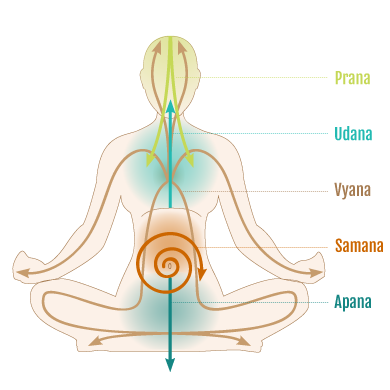
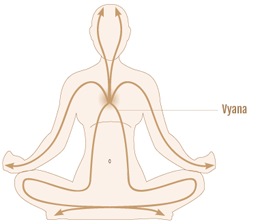
Called the Omnipresent Air
The Vyana Vayu is the lifeforce energy driving body systems including movement, nerves, heartbeat, circulation, joints, and muscles. It also promotes the movement of prana through the nadis.
A balanced yoga practice will help vyana to flourish. Standing poses are particularly beneficial, because they involve movement of every part of the body, from the center outward. Warrior poses, Trikonasana (Triangle Pose), and Utkatasana (Chair Pose) are excellent balancers of vyana. In addition, the vyana-balancing pranayama practice of nadi shodhana (alternate nostril breathing) will also be beneficial.
Sometimes Called Ascending Air
The Udana Vayu carries kundalini energy (the energy awakened during a yoga practice) from the lower level of consciousness to the upper levels. It is located between the head and the heart.
Communication issues are seen to indicate an imbalance of Udana.
Balance the Udana Vayu by doing inversion poses at the culmination of an asana practice. Poses such as Setu Bandha Sarvangasana (Bridge Pose), Sarvangasana (Shoulderstand), Halasana (Plow Pose), Matsyasana (Fish Pose), and Sirsasana (Headstand) are recommended.
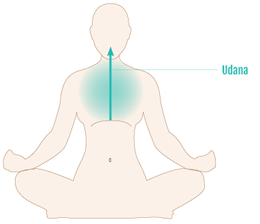
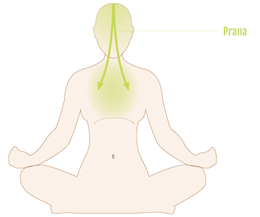
The Prana–Vayu is situated in the head, centered in the third-eye, and its energy pervades the chest region. It supports the physical senses of taste, smell, hearing, touch and vision, nourishes the brain, and supports the brain's processing of what is taken in by the senses.
Prana and Apana Vayu can be balanced simultaneously with a balancing/breathing exercise.
Called Balancing Air
Located at the solar plexus chakra, where the prana vayu meets the apana vayu, heat and air are brought together to produce fire. This energy force helps us take in what we need and release what we don't.
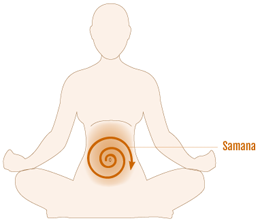
Balancing Samana Vayu
Breath practices that practice balancing inhalation with exhalation are helpful as a way to balance samana. By matching the length and depth of each inhalation and exhalation, prana meets apana, thereby helping to balance samana. Asanas to practice for optimizing samana include Parivritta Parshvakonasana (Revolved Side Angle Pose), Utkatasana (Chair Pose), Shalabasana (Locust Pose), Marichyasana (Sage Twist), Paschimottanasana (Seated Forward Fold), and proper engagement of Uddiyana Bandha, or navel lock, upon each exhalation.
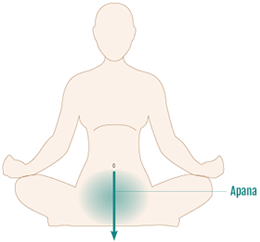
Apana vayu supports the outward flow of energy from the body including breath, digestive elimination, and with menstruation. This energy force is located at the root chakra.
Prana and Apana Vayu can be balanced simultaneously with a balancing/breathing exercise.
[Home] [Projects] [Links] [Contact Me]
Design by Vicky Woodard
Copyright © 2017 Vicky Woodard
Last updated May, 2017
All Rights Reserved